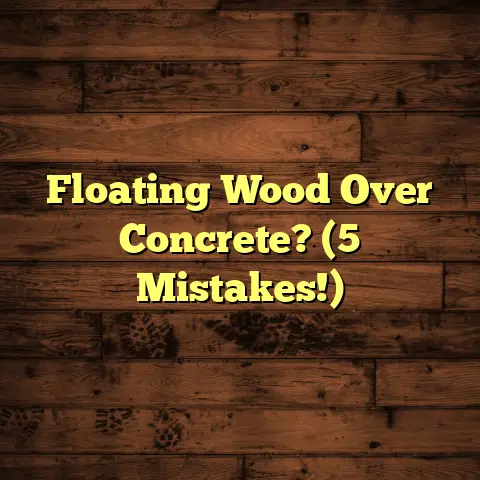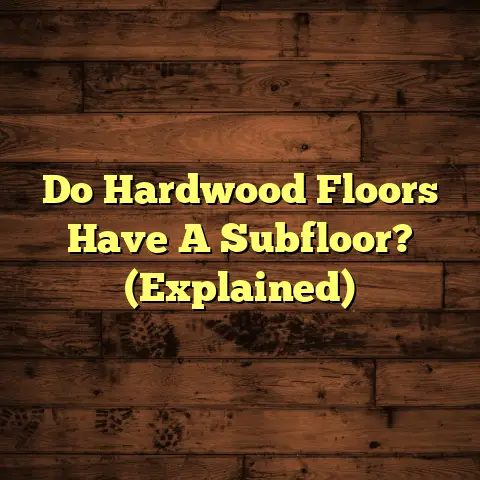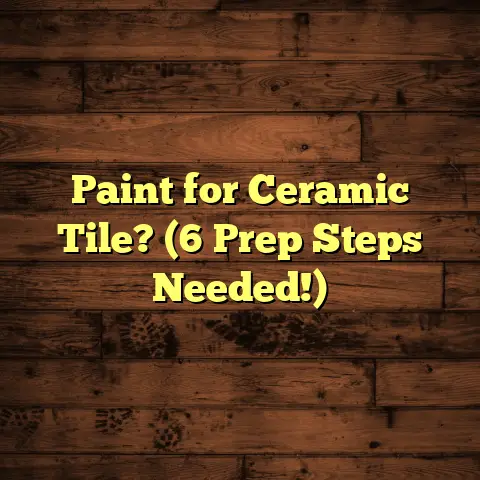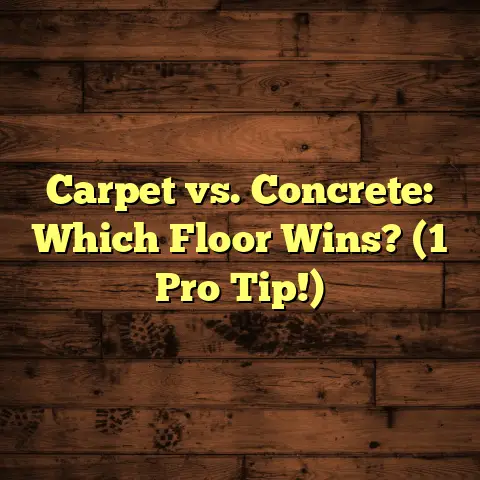Under Treadmill On Hardwood? (4 Options!)
More and more of us are bringing the gym home, especially with treadmills. I get it! It’s convenient, saves time, and you can binge-watch your favorite shows while you get your steps in.
But let’s be real: hardwood floors and heavy exercise equipment aren’t always the best of friends. Hardwood is a big investment, and it adds so much beauty to a home. The last thing you want is for your treadmill to turn it into a scratched-up, dented mess.
That’s why I’m here to walk you through four practical ways to protect your precious hardwood from the pounding and pressure of your treadmill. Think of it as a little preventative care that can save you a lot of headaches (and money!) down the road. Let’s dive in!
Section 1: Importance of Protecting
Hardwood Floors
So, why all the fuss about protecting your hardwood? Let’s break it down.
Hardwood flooring is prized for its durability, timeless beauty, and the warmth it brings to a room. It’s a natural product, and that’s part of its charm. But that also means it’s susceptible to certain types of damage.
Think about it: hardwood is essentially wood, right? And wood, while strong, can be scratched, dented, and warped by moisture.
Now, picture a heavy treadmill, weighing hundreds of pounds, sitting in one spot. Every time you use it, that weight is concentrated on a small area. The vibrations and impact from your running or walking add even more stress.
Over time, this can lead to:
- Indentations: The legs of the treadmill can leave permanent dents in the wood.
- Scratches: Even small movements of the treadmill can cause scratches, especially if there’s any dirt or debris trapped underneath.
- Finish Wear: The constant pressure and friction can wear down the protective finish on your hardwood, making it more vulnerable to damage.
- Moisture Damage: Sweat, spills, and even humidity can seep under the treadmill and cause warping or staining.
I’ve seen it happen countless times. Homeowners get so caught up in their fitness routines that they forget about the potential impact on their floors.
Here’s a statistic that might make you think: According to the National Wood Flooring Association (NWFA), proper care and maintenance can extend the life of hardwood flooring by decades. Neglecting your floors, on the other hand, can lead to costly repairs or even replacement. We are talking about $5-$15 per square foot to repair or replace hardwood flooring.
Think about the cost of refinishing or replacing a section of hardwood flooring versus the cost of a good treadmill mat. It’s a no-brainer, right?
Protecting your hardwood isn’t just about aesthetics; it’s about protecting your investment and ensuring that your floors stay beautiful for years to come.
Section 2: Option 1 – Treadmill Mats
Alright, let’s talk about the first and perhaps most popular option: treadmill mats.
What exactly are these things? Treadmill mats are specifically designed to go under your treadmill (or other exercise equipment) and provide a protective barrier between the machine and your floor.
They’re typically made from materials like:
- Rubber: Rubber mats are durable, shock- absorbent, and water-resistant. They’re a great all-around choice.
- Foam: Foam mats (like EVA foam) are softer and often come in interlocking tiles. They’re good for absorbing impact and reducing noise.
- PVC: PVC mats are budget-friendly and easy to clean, but they might not be as durable as rubber or foam.
The benefits of using a treadmill mat are numerous:
- Shock Absorption: Mats cushion the impact of your workouts, reducing stress on both your treadmill and your floors.
- Noise Reduction: They dampen vibrations and noise, which is especially important if you live in an apartment or have downstairs neighbors.
- Floor Protection: They create a barrier against scratches, dents, and moisture.
- Treadmill Stability: Some mats have a textured surface that helps prevent the treadmill from slipping or sliding during use.
Choosing the Right Mat
So, how do you pick the right mat for your treadmill and your hardwood floors? Here are a few things to consider:
- Size: Measure the footprint of your treadmill and choose a mat that’s slightly larger. You want to make sure all the legs of the treadmill are fully supported.
- Thickness: A thicker mat will provide more cushioning and protection. Look for mats that are at least 1/4 inch thick, and preferably thicker if your treadmill is particularly heavy.
- Material: Rubber is generally the best choice for durability and water resistance. Foam is good for noise reduction and comfort. Consider the weight of your treadmill when selecting the right mat.
- Texture: A textured surface will help prevent the treadmill from slipping.
- Price: Treadmill mats range in price from around \$20 to \$100 or more. Consider your budget and your needs when making your decision.
I’ve had clients who swear by their treadmill mats. One client, Sarah, told me that her rubber mat not only protected her hardwood floors but also made her treadmill quieter, which was a huge plus since she liked to work out early in the morning.
Another client, Tom, used interlocking foam tiles under his treadmill. He loved that he could customize the size and shape of the mat to fit his space perfectly.
Pro-Tip: Always clean your treadmill mat regularly to remove dirt and sweat. This will prevent the buildup of grime that can scratch your floors.
Section 3: Option 2 – Carpet or Area Rugs
Now, let’s explore another option that’s both functional and stylish: using carpet or area rugs under your treadmill.
While not specifically designed for exercise equipment, carpets and rugs can provide a decent level of protection for your hardwood floors, especially if you choose the right type.
Here’s what you need to know:
Advantages of Carpet or Rugs:
- Added Cushioning: Carpets and rugs provide a layer of cushioning that can absorb shock and reduce stress on your floors.
- Noise Reduction: Like treadmill mats, they can help dampen vibrations and noise.
- Aesthetic Appeal: Carpets and rugs can add a touch of style and personality to your workout space. You can choose a color and pattern that complements your home decor.
- Cost-Effective: Depending on what you choose, carpet or rugs can be a cheaper option than dedicated treadmill mats.
Choosing the Right Rug:
Not all rugs are created equal. Here are some factors to consider when selecting a rug for under your treadmill:
- Thickness: A thicker rug will provide more cushioning and protection. Look for rugs with a dense pile.
- Durability: Choose a rug that’s made from durable materials like nylon or polypropylene. These materials are resistant to wear and tear.
- Non-Slip Backing: This is crucial! You don’t want the rug to slide around under the treadmill. Look for rugs with a rubber or latex backing.
- Size: As with treadmill mats, make sure the rug is large enough to fully support the treadmill’s footprint.
- Material: Natural fiber rugs like wool or cotton can be comfortable, but they may not be as durable or water-resistant as synthetic materials.
Maintaining Rugs Under Treadmills:
Here’s the thing about rugs: they can trap moisture and dirt. To prevent this, you need to be diligent about maintenance:
- Vacuum Regularly: Vacuum the rug frequently to remove dirt and debris.
- Clean Spills Immediately: Blot up spills as soon as they happen to prevent staining and moisture damage.
- Use a Rug Pad: A rug pad (in addition to the rug itself) can provide extra cushioning and prevent the rug from slipping.
- Air It Out: Occasionally, lift the rug and air it out to prevent moisture buildup underneath.
I had a client, Mark, who used a thick, durable area rug under his treadmill. He said it not only protected his floors but also made his workout space feel more inviting.
However, I also had a client, Lisa, who used a thin, flimsy rug under her treadmill. The rug quickly became worn and torn, and it didn’t provide much protection for her floors.
Important Note: While carpets and rugs can offer some protection, they’re not as effective as dedicated treadmill mats. If you’re serious about protecting your hardwood floors, a treadmill mat is still the best option.
Section 4: Option 3 – Floor Protectors
or Pads
Let’s move on to another option that’s often overlooked but can be surprisingly effective: floor protectors or pads.
These are small, inexpensive accessories that you attach to the feet of your treadmill to prevent them from scratching or denting your floors.
Types of Floor Protectors:
There are several different types of floor protectors available:
- Felt Pads: These are soft, adhesive pads that stick to the bottom of the treadmill’s feet. They’re good for preventing scratches, but they may not provide much cushioning.
- Rubber Sliders: These are small, rubber discs that allow you to easily slide the treadmill across the floor without damaging it.
- Plastic Cups: These are small, plastic cups that the treadmill’s feet sit inside. They provide a barrier between the feet and the floor.
- Adjustable Leveling Feet: These replace the existing feet on your treadmill and allow you to adjust the height of each foot to level the machine.
Installation and Maintenance:
Installing floor protectors is usually a simple process:
- Clean the Feet: Clean the bottom of the treadmill’s feet to remove any dirt or debris.
- Attach the Pads: Peel off the backing from the adhesive pads and stick them to the bottom of the feet.
- Test the Stability: Make sure the treadmill is stable and doesn’t wobble.
The key to success with floor protectors is regular maintenance. You need to:
- Check the Pads Regularly: Make sure the pads are still securely attached to the feet. Replace them if they’re worn or damaged.
- Clean the Floor: Keep the floor around the treadmill clean to prevent dirt and debris from getting trapped under the pads.
I had a client, David, who used felt pads under his treadmill. He said they worked great for preventing scratches, but he had to replace them every few months because they wore out quickly.
Another client, Maria, used rubber sliders under her treadmill. She loved that she could easily move the treadmill around when she needed to clean the floor.
Important Note: Floor protectors are a good option for preventing scratches, but they don’t provide much cushioning or noise reduction. If you’re looking for more comprehensive protection, you’ll need to consider a treadmill mat or carpet.
Section 5: Option 4 – Professional
Installation of Protective Flooring
Now, let’s talk about the most comprehensive (and often most expensive) option: professional installation of protective flooring.
This involves installing a dedicated layer of protective flooring under your treadmill, such as vinyl, engineered wood, or even specialized gym flooring.
Benefits of Professional Installation:
- Longevity: Professionally installed flooring is designed to last for many years.
- Durability: It’s typically more durable than treadmill mats or carpets.
- Seamless Integration: It can be seamlessly integrated with your existing flooring, creating a cohesive look.
- Customization: You can choose from a wide range of colors, styles, and materials to match your home decor.
- Increased Home Value: Upgrading your flooring can increase the value of your home.
The Installation Process:
The installation process typically involves the following steps:
- Consultation: A flooring contractor will assess your needs and recommend the best type of flooring for your situation.
- Preparation: The contractor will prepare the subfloor by cleaning it and leveling it if necessary.
- Installation: The contractor will install the new flooring, making sure it’s properly secured and sealed.
- Finishing: The contractor will add any necessary finishing touches, such as baseboards or trim.
Potential Costs:
The cost of professional flooring installation can vary widely depending on the type of flooring you choose, the size of the area, and the complexity of the installation.
Expect to pay anywhere from \$5 to \$15 per square foot for materials and installation.
Finding a Contractor:
Choosing the right contractor is crucial. Here are some tips:
- Get Recommendations: Ask friends, family, or neighbors for recommendations.
- Check Online Reviews: Read online reviews to see what other customers have to say.
- Get Multiple Quotes: Get quotes from several different contractors before making a decision.
- Check Licensing and Insurance: Make sure the contractor is licensed and insured.
- Ask Questions: Don’t be afraid to ask the contractor questions about their experience, their process, and their warranty.
I spoke with a flooring industry professional, John, who said that investing in professional flooring installation is a worthwhile investment for serious fitness enthusiasts. He said it provides the best long-term protection for hardwood floors and can significantly enhance the workout experience.
Important Note: Professional flooring installation is the most expensive option, but it’s also the most comprehensive and long-lasting. If you’re serious about protecting your hardwood floors and you have the budget, it’s definitely worth considering.
Conclusion
So, there you have it: four options for protecting your hardwood floors from the potential damage caused by your treadmill.
Let’s recap:
- Treadmill Mats: A popular and effective way to absorb shock, reduce noise, and protect your floors.
- Carpet or Area Rugs: A stylish and cost-effective option, but not as durable as treadmill mats.
- Floor Protectors or Pads: An inexpensive way to prevent scratches, but they don’t provide much cushioning.
- Professional Installation of Protective Flooring: The most comprehensive and long- lasting option, but also the most expensive.
Which option is right for you? It depends on your individual needs, preferences, and budget.
Consider these factors:
- The Weight of Your Treadmill: Heavier treadmills require more robust protection.
- Your Workout Frequency: If you use your treadmill frequently, you’ll need a more durable solution.
- Your Budget: How much are you willing to spend to protect your floors?
- Your Aesthetic Preferences: Do you want something that blends in with your home decor?
No matter which option you choose, remember that taking proactive steps to protect your hardwood floors is an investment in your home and your fitness journey. It’ll help you maintain a beautiful and functional workout space for years to come.
So, go ahead, get your sweat on! But don’t forget to protect those floors!





